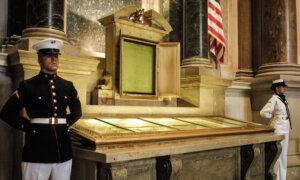Many believe that America’s most important export is the U.S. Constitution, which has been replicated around the world. “The authors of the Constitution understood it would be impossible to rein in a corrupt human being so they simply constructed a government which pitted corruptible human beings against each other,” wrote Alex Madajian on the Fourth Estate website.
The Beginning

This book offers a dramatic recreation of the Constitutional Convention. It goes beyond politics, offering a glimpse into the Founding Fathers’ personal lives and relationships. Mr. Baier emphasizes George Washington’s role in forming the Constitution. It was his celebrity and personality that brought delegates together to work out a set of laws for everyone.
This is terrific to read because today President Washington faces criticism.

The original Constitution explicitly condoned the practice of slavery and protected slaveholders’ rights. Thus, the Constitution was unsuitable to a new era. However, amendments were allowed for the Constitution’s modification and for a change from a government that allowed slavery to one that ensured freedom.
Three Reconstruction amendments were adopted. The 13th Amendment established that freeing people was not the same thing as abolishing slavery. State laws that had established slavery remained on the books and had to be repealed.
The 14th Amendment addressed citizenship rights and equal protection under the laws for all people.
The 15th Amendment secured for U.S. citizens the right to vote. This right would not be denied or abridged by the federal or state government on account of race, color, or previous condition of servitude.
Maintaining Constitutional Balance

During the previous two years, the high court struck down several key pieces of New Deal legislation on the grounds that the laws delegated unconstitutional authority to the executive branch.

At the time of President Roosevelt’s reelection, the Court was the most elderly in the nation’s history, averaging age 71. Roosevelt asked Congress to empower him to appoint an additional justice for any member of the court over age 70 who did not retire. The Constitution was silent about the Court’s size. The seats on the nation’s highest bench had only numbered nine since 1870. That was in the living memory of some of the then-current justices living.
The president’s proposal would have undoubtedly jeopardized constitutional balance within the federal government in favor of the elected branches, by increasing their leverage over the judiciary. Many Americans believed the high court was sacrosanct, and opposed to the Washington plan. For 168 days, the fight over expanding the Supreme Court played out all over America.
Mr. Solomon’s book focuses on this period of time. The book begins in 1937 when 85 guests assembled to partake in the president’s annual dinner for the Supreme Court justices. The dinner was his best chance to hobnob with these secluded individuals.
Mr. Solomon goes into great detail about what happened there and afterwards. The readers will feel like flies on the wall at this dinner. The attention to minute details here and throughout the book make it a real winner.
Roosevelt’s bill was defeated. The institutional integrity of the U.S. Supreme Court was preserved—its size had not been manipulated for political or ideological ends.
Extraconstitutional Action

In 2021, Secretary of Defense Lloyd J. Austin III issued a memorandum directing mandatory COVID-19 vaccinations for all servicemembers. Mr. Green shared his own account of seeking religious exemption for himself and others from the Department of Defense COVID-19 vaccine mandate.
Mr. Green pointed out that the military has felt the effects of a recent value system change. As an institution, the U.S. military was historically a bastion of traditional values, but was moving away from that idea. However, Mr. Green, as an officer, did not feel justified in speaking out about these changes until what he viewed was unconstitutional: the COVID-19 vaccination law.
Officers swear an oath to serve the Constitution and only the Constitution. Enlisted men, on the other hand, swear an obligation to both the Constitution and to follow the lawful orders given to them. Mr. Greene reminds us that joining the military doesn’t mean sacrosanct rights are forfeited. The tactics used to enforce the vaccination order ranged from simply informing service members of the order to comply to discriminatory treatment. Mr. Green went into horrifying detail about the methods used to force compliance.

In January 2023, the vaccine mandate was overthrown. Today, Mr. Green and others seek accountability from those who pushed this failed policy on our military. The leaders drained the military of those with the backbone to stand up against forced vaccinations. Others who took the vaccination found themselves sick or dying as a result of unnecessary and untested vaccines. He asserts that trust in basic military mission and leadership had been lost.





